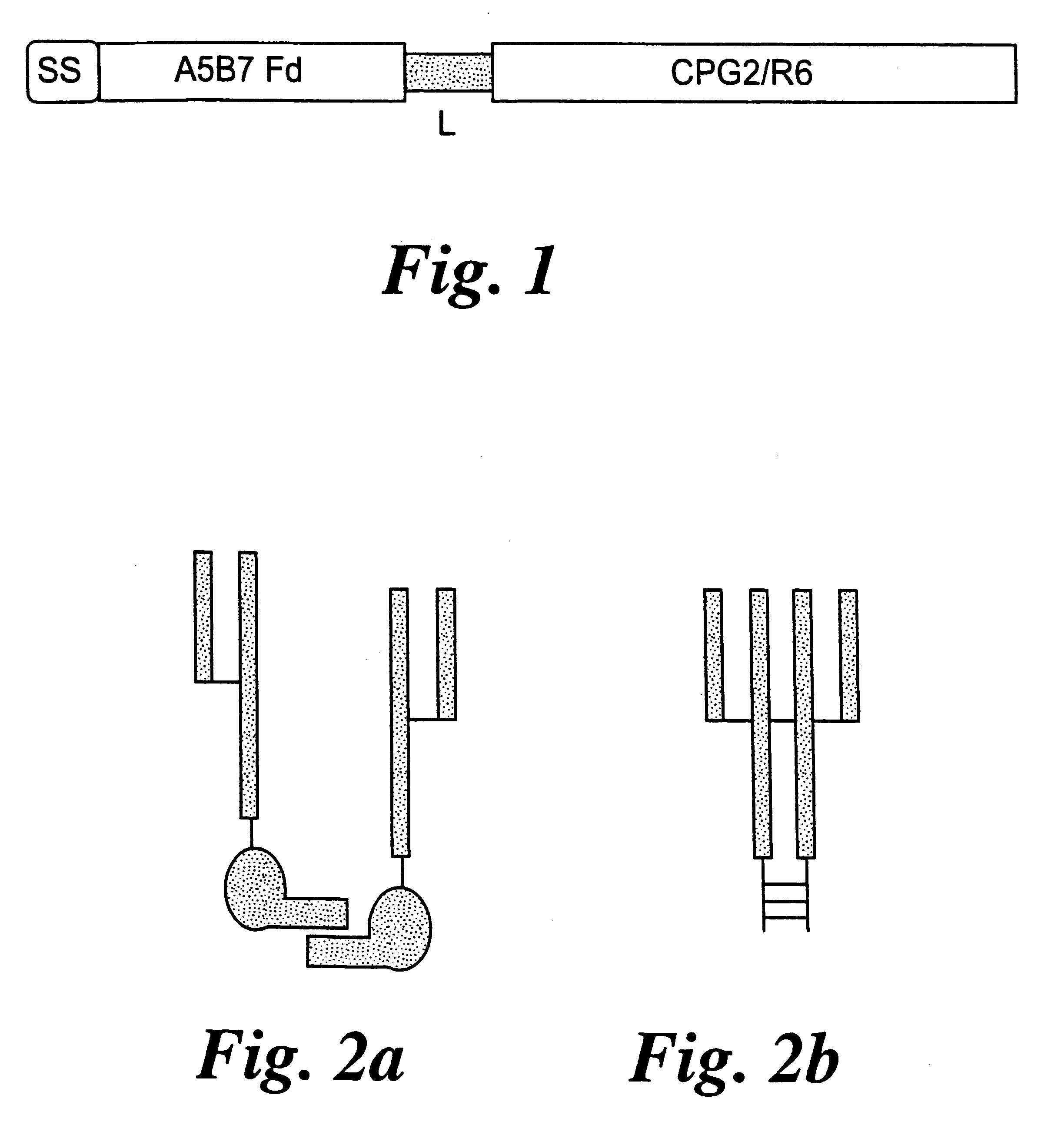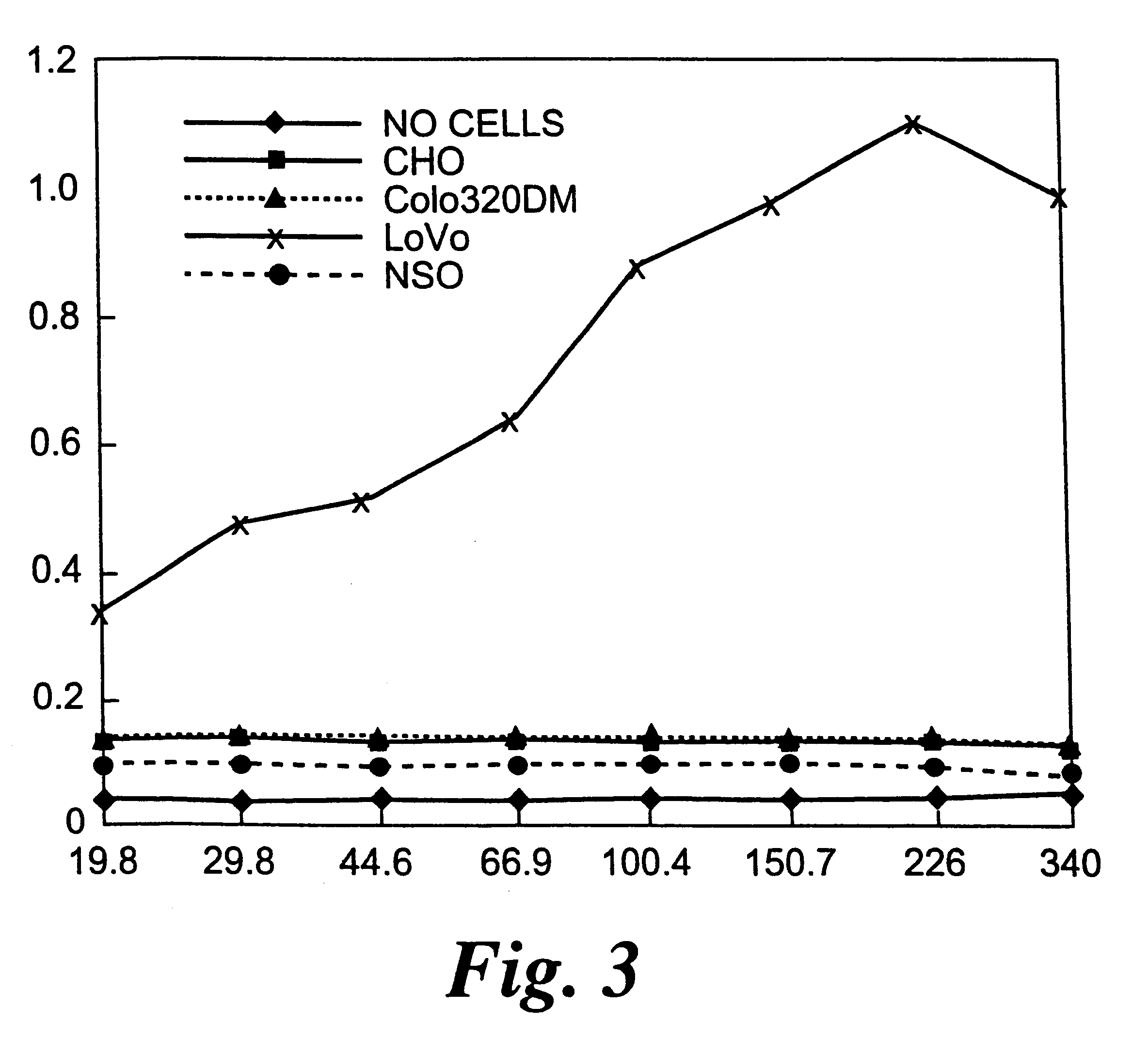Gene construct encoding a heterologous prodrug-activating enzyme and a cell targeting moiety
- Summary
- Abstract
- Description
- Claims
- Application Information
AI Technical Summary
Benefits of technology
Problems solved by technology
Method used
Image
Examples
example 2
HCT116 Tumour Cells Expressing the Antibody-enzyme Fusion Protein are Selectively Killed in vitro by a Prodrug
HCT 116 colorectal tumour cells (ATCC CCL 247) transfected with the antibody-CPG2 fusion protein gene of Example 1 can be selectively killed by a prodrug that is converted by the enzyme into an active drug.
To demonstrate this, control non-transfected HCT116 cells or HCT116 cells transfected with the antibody-CPG2 fusion protein gene, are incubated with either the prodrug, 4-[N,N-bis(2-chloroethyl)amino]-phenoxycarbonyl-L-glutamic acid (PGP; Blakey et al, Br. J. cancer 72, 1083, 1995) or the corresponding drug released by CPG2, 4-[N,N-bis(2-chloroethyl)amino] phenol. PGP prodrug and drug over the concentration range of 5.times.10.sup.-4 to 5.times.10.sup.-8 M are added to 96 well microtitre plates containing 1000-2,500 HCT116 cells / well, for 1 hr at 37.degree.. The cells are then washed and incubated for a further three days at 37.degree.. After washing to remove dead cells, ...
example 3
Anti-tumour Activity of PGP Prodrug in HCT116 Tumours Expressing the Antibody-CPG2 Fusion Protein
The anti-tumour activity in vivo of the PGP prodrug in HCT116 tumours expressing the antibody-CPG2 fusion protein can be demonstrated as follows. HCT116 tumour cells transfected with the antibody-CPG2 fusion protein gene or control non-transfected HCT116 tumour cells are injected subcutaneously into athymic nude mice (10.sup.7 tumour cells per mouse). When the turnours are 5-7 mm in diameter the PGP prodrug is administered i.p. to the mice (3 doses at hourly intervals over 2 h in dose ranges of 5-25 mg kg.sup.-1). The anti-tumour effects are judged by measuring the length of the tumours in two directions and calculating the tumour volume using the formula:
Volume=.pi. / 6.times.D.sup.2.times.d
where D is the larger diameter and d is the smaller diameter of the tumour.
Tumour volume is expressed relative to the tumour volume at the time the PGP prodrug is administered. The anti-tumour activity...
example 4
Improved Transfection of Adherent Cell Lines Using Supplemented FAS Media and / or V-79 Feeder Cells
It was foreseen that in vitro expression of CPG2 and CPG2 fusion proteins in mammalian cells may degrade media folates leading to slow cell growth or cell death. FAS (folinic acid supplemented) media described herein was developed for CPG2 and CPG2 fusion protein expressing cell lines in order to better support the growth of such cell lines.
In preparation for transfection, adherent cell lines were cultured in normal DMEM edia and passaged at least three times before transfection. V-79 (hamster lung fibroblast, obtained from MRC Radiobiology Unit, Harwell, Oxford, United Kingdom) feeder cells were cultured in normal DMEM media and passaged three times before use. For the transfection, a viable count (using a haemocytometer / trypan blue staining) of the adherent cells was made and the cells plated out at 2.times.10.sup.5 cells per well into a 6 well plate (Costar 3516) and left for 18-24 h...
PUM
| Property | Measurement | Unit |
|---|---|---|
| Surface | aaaaa | aaaaa |
| Cytotoxicity | aaaaa | aaaaa |
Abstract
Description
Claims
Application Information
 Login to View More
Login to View More - R&D
- Intellectual Property
- Life Sciences
- Materials
- Tech Scout
- Unparalleled Data Quality
- Higher Quality Content
- 60% Fewer Hallucinations
Browse by: Latest US Patents, China's latest patents, Technical Efficacy Thesaurus, Application Domain, Technology Topic, Popular Technical Reports.
© 2025 PatSnap. All rights reserved.Legal|Privacy policy|Modern Slavery Act Transparency Statement|Sitemap|About US| Contact US: help@patsnap.com



